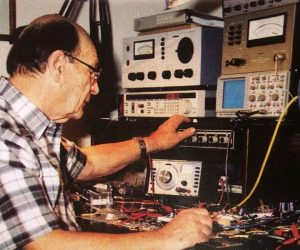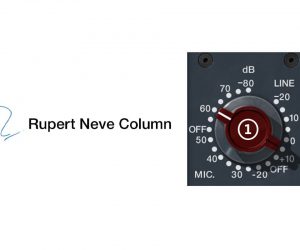
Rupert Neve Designs 5088
Very few consoles have been more highly anticipated than the Rupert Neve Designs 5088 fully discrete analogue mixer. It might be the first console to leave the Rupert Neve Designs’ stable, but its pedigree is unquestionable.
Has there ever been a bigger name in pro audio than Rupert Neve? At 81, Rupert is well and truly the patriarch of the pro audio industry. At trade shows he’s mobbed like Elvis, and with virtually the whole history of analogue mixing peppered with his sonic imprint, he is one of the most influential audio circuit designers of all time.
He once joked to me at an AES conference that he wished his old designs would just ‘up and die’ so that his newer, cleaner and better spec’d models could get a look in. ‘They just won’t go away,’ he remarked, laughing (as he also was that day) about the ‘legend’ status everyone affords him. Clearly comfortable with his legacy, and yet keener than ever to push forward with better and newer designs, Rupert Neve seems destined to be designing audio equipment right up until the day he drops off his perch. That in itself speaks volumes about how obsessed with audio the man truly is. I mean, how many of us see ourselves powering forward in the audio industry at 81?
HI EX-SPEC’D TATION
It’s been a much-anticipated console, the new 5088. Beyond the normal level of expectation that any new equipment bearing Rupert’s fingerprints (as opposed to his name) usually generates, news of a new no-compromise, back to basics, and yet relatively affordable console recently saw people literally salivating at the prospect. Everyone began queuing up like impatient football supporters at a hotdog stand, when the news first broke. Unlike much of the equipment Rupert Neve has produced in the last decade or so, this was (apparently) going to be the first ‘affordable’ console he’d ever produced, and all seemingly without the restrictions of working for another company (his last role was as a designer for the now defunct Amek). Everyone has assumed that, for Rupert at least, the 5088 console represents the attitude that: ‘at my age I can do what I want and nobody’s gonna stop me’. But it’s not as simple as that. Even after four decades, there’s no-one writing Rupert a blank cheque, indeed, these days he writes his own.
STYLE & GRACE
Sitting at the 5088 console has been something I’ve been anticipating doing for months. I’ve had it in my safe keeping for weeks now and it’s been a real case of setting it up, plugging it in and going for it. I haven’t had a lot of time to pour over the fine detail too much, let alone wire it comprehensively into a patchbay (which you really must do to get the most out of it). But one thing I have done is listen and mix through it intensively.
First impressions of the 5088 were good. Ergonomically and aesthetically the console is all class. It’s a relatively small console in its 16-channel format – an ideal size for a wide range of studio environments (multiple 16-channels expansion chassis can also be added to the console until you run out of room – or cash). Its pale blue faceplates and low-sheen red, navy and silver knobs combine to create a clean and relaxing knob-scape (can I use that word?). White switches – that look like pegs from the bridge of an acoustic guitar – are used extensively throughout the board to activate pan, select groups, tape/line and bus inputs etc. These feel a little fiddly to the touch, but work well. The overall presentation is not too dissimilar to a Quad Eight Coronado, in fact, without being able to compare them directly. The Alps faders feel smooth and luxurious while the large square backlit solo and mute switches act forcefully and definitively, almost to the point of seeming obstinate.
The ‘Penthouse’, which is the fancy name for the upper deck that houses any combination of Portico modules you care to nominate, rakes up at an impressively steep 45º angle, placing the upper controls within relatively easy reach. This ‘kick’ also imparts a definite ‘retro’ vibe. My ideal setup for this upper deck would simply involve arranging 16 preamp/EQ Portico modules in a standard console strip configuration, directly above the line input trim and auxiliary send controls. Other people might like to have a mixture of different components scattered across the Penthouse – each to their own. It’s entirely up to you how this Penthouse is arranged. Modularity is a key aspect of the design.
Across the top of all of this – like icing atop a vintage cake – fly two rows of beautifully accurate VU meters, one for each of the 16 channel inputs and eight group outputs (odd numbers across the top and even numbers below). Meanwhile, the stereo output master VUs sit below the meter bridge on the lower deck, clearly labelled ‘Left’ and ‘Right’. Each VU carries Rupert’s now unmistakable signature, which nowadays simply consists of a swirling capital ‘R’ (I can count 28 of them from the mix position). But one for each VU is a bit over-the-top in my opinion, and being that the ‘R’ is the exact same thickness as the VU’s needle, the letter actually becomes quite distracting. Finally, wrapping up all of this superbly crafted analogue circuitry are a smooth leather armrest and elegant dark timber sides.
Physically, the 5088 feels like a giant Neve Melbourn from the ’70s, albeit more extensive and comprehensive. It’s built like a tank, exactly as you would hope it might be. Modules slip in and out of the console with guillotine-like precision, reminiscent of his ‘vintage’ designs, and the circuitry each one houses reflects the decades of experience Rupert Neve has accumulated. The circuit board layouts look good and all the components are designed to be serviceable ‘for decades to come’. To that end, the console hits the spot perfectly.
SOUNDING BOARD
But above all else vintage Neve consoles are famous for one thing: their sound. They’re certainly not known for their brilliant ergonomics or comprehensive mixing options – that’s where SSL stepped into the limelight – and, to that end, Rupert Neve has certainly harked back to his earlier designs to develop the modular 5088, resisting any temptations to add any extra bells and whistles. It’s not feature-packed by any means; it’s unashamedly about sound quality. So it makes sense then that everyone is keen – above all else – to know what the console sounds like, as was I.
To cut right to that chase, from my experience with the board, the 5088 is the cleanest, purest and most open sounding console I’ve heard in a long time. Beyond that it’s hard to attribute many adjectives to it without them seeming preemptive or presumptuous – [after all, the sound of a console is assessed over years, even decades, not weeks].
The 5088 has more headroom than my old Ford XC Panelvan. Its so impressive, in fact, that I really never actually heard the board push back against the input signals during the whole time I used it. It seems that before you’d ‘hear’ the console, in a way you might hear an old Neve circuit distort, you’d probably find you’d broken off all the needles on the channel and output VU meters. To many this might actually sound like quite disappointing news, particularly given the ‘retrospective’ nature of its Class-A, transformer-balanced design. But to expect an old ’70s sound from this board is to misunderstand one important fact: although Rupert Neve has reverted to a simpler layout, and chosen quality components to construct an ‘uncompromised’ signal flow, he certainly hasn’t gone back in time to a world of high distortion components and inferior circuit analysis techniques to design the 5088. In every technical respect the 5088 is cutting edge – like the Neve consoles of the early ’70 were in their day. Rupert had no intention of making something “inferior,” as he puts it. He’s obsessed with providing the best possible product – always has been – and, unfortunately, those searching for ‘rock’ distortion specs and vintage 80-Series punch will need to look elsewhere.
What you will find in the 5088 is a stereo mix bus that offers superb depth of image, great phase coherence and a rock-solid soundstage. As a line level summing mixer you’d be hard pressed to find anything better anywhere on the market. And given that Rupert’s aim for the 5088 was to provide “the highest possible sound quality to complex digital or analogue recording systems” you’d have to say he’s been highly successful. Unlike old Neve consoles that everyone rightly or wrongly claims ‘has a sound, no matter what do on the board’, the 5088 sounds open and versatile and will probably never earn the reputation as a ‘one-trick pony’.
RESOLUTELY MODERN
So what does it offer then, if not that ‘vintage’ sound? Well, as the centerpiece of an analogue stereo mixing environment, where a small footprint, high quality summing mixer is required, the 5088 is a great option. There are professional features like VU metering, a built-in oscillator, multiple talkback options, three speaker selection options, as well as the ability to monitor auxiliaries 1&2, the solo bus, and three external inputs. All eight auxiliary sends can be muted (in pairs) while auxs 1&2 and 3&4 (in stereo mode) can have their pan pot overridden by the channel pan, via the ‘Send Follows Pan’ switch. The pan pots can also be switched in and out of service as required, guaranteeing centred audio placement and improving headroom specs. The eight groups each have Stereo Left, Stereo Right and Group Insert switches above each individual group’s pan pot, as well as solo and mute switches (The solo switches also provide simple visual overload informationby changing colour when they’re hit hard, in the same way some VUs might have a small peak LED contained within them). The auxiliary masters also have solo and mute switches. The master section has five talkback routing paths and a master talkback switch that doesn’t ‘latch’.
Although this list constitutes only some of the board’s facilities, while space permits there are a few obvious things missing from the 5088, and other ‘unusual’ design decisions that should be mentioned.
Given the console must surely be capable of, for instance, mixing music, the concept of a ‘line mixer with optional extras’ won’t satisfy everyone’s expectations. Let’s say, for instance, that you wanted to buy a 5088 but you didn’t want the ‘optional extras’ of an upper penthouse filled with mic-preamp/EQ modules etc. In that case you’d be buying a console that contained no EQ and no mic preamps, only line trims and auxiliary sends. Moreover, the comprehensive back panel (that offers a veritable phalanx of connectivity) doesn’t include channel inserts, only group and stereo inserts, which makes the core lower deck of the console feel a little restricted, again, without a patchbay. With an upper deck comprising 16 preamp/EQ Portico modules, and with all the console connectors reflected on a professional patchbay, inserting things like external compressors and EQs etc would be a simple matter of patching between the preamp output and the line input. However, without these extra modules feeding the line inputs, and without a dedicated patchbay, this is impossible without interrupting the signal before it even reaches the console, which isn’t ideal. So, without question, a patchbay is mandatory if you intend using the 5088 for any involved mixing duties.
Other peculiar features are solo switches that only work if you’re monitoring the ‘solo’ bus on the right-hand side of the console. To solo you must first select ‘Solo’ at the monitor controller, at which time you hear silence, and then hit a channel, group or auxiliary solo to hear signal. Conversely, you could solo individual channels first and then hit the ‘solo’ switch at the monitor controller, but whichever way you go about it, it feels clunky.
There is no headphone jack input to monitor signals either, even though there is ample space on the console to accommodate one. Comprehensive monitoring these days really should include some sort of headphone setup and without this facility the console feels a little restrictive. Having to monitor in headphones via a separate system feeding off the stereo output bus during mixdown was a drag, in my experience, especially given there was patently so much wide open space on the board. Lastly, because the console contains Class-A circuitry throughout, the design includes fans to prevent overheating, and these are not as ‘silent’ as the literature suggests. They’re not noisy, but they’re distracting at times when you’re listening to low-level audio. I’d love to see these improved if possible, or, better still, removed altogether.
These criticisms aside, if you’ve got the funds available and you’re looking for a superbly clear, supreme line mixer, the 5088 is a must-see. It’s beautifully constructed and a genuine credit to Rupert Neve’s skills as a designer. The mix bus sounds fabulous and the facilities it offers are first class, and highly spec’d. Having things like VUs on every channel and output bus is very handy indeed and great for managing gain structure at a glance. But without the added penthouse section the console feels a little trapped between worlds (given there’s no EQ, dynamics control or mic preamps on the lower deck). So unless you fill the upper ‘Penthouse’ full of modules and connect it to a patchbay, don’t expect it to comprehensively mix that next masterpiece you’ve recorded. Meanwhile, for summing a pristine DSD recording or feeding an elaborate digital mix into an analogue environment, it’s perfect.


























With respect !!!